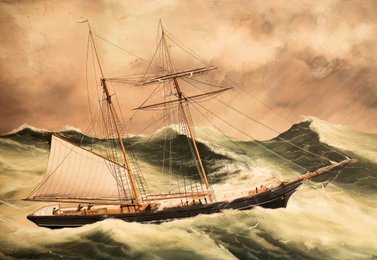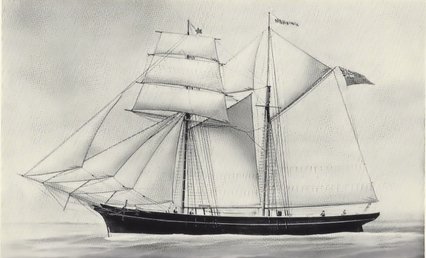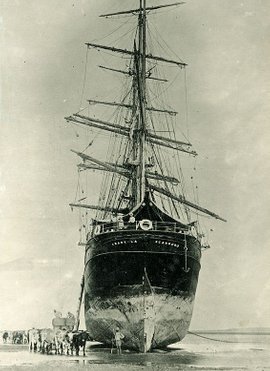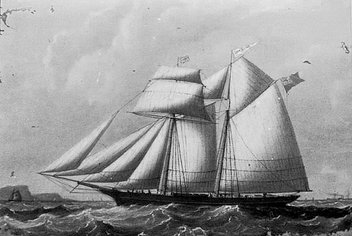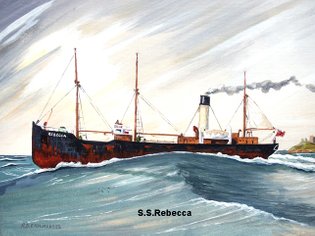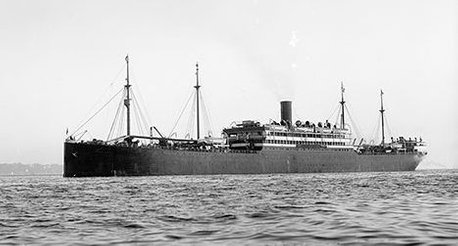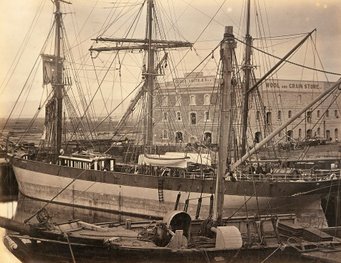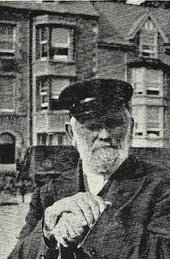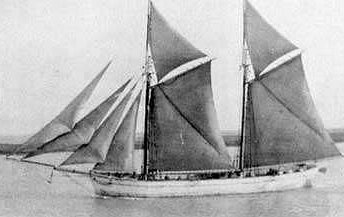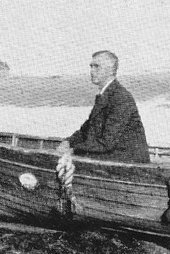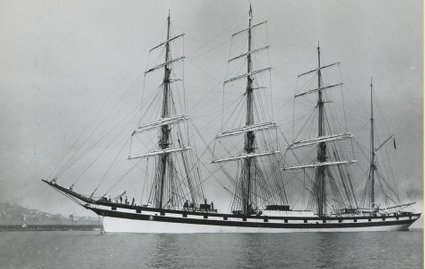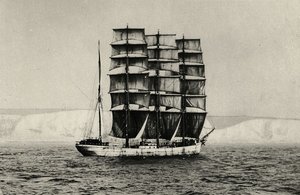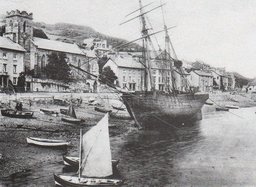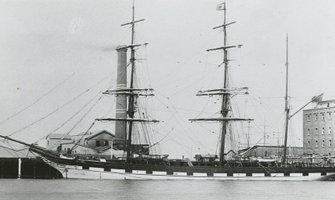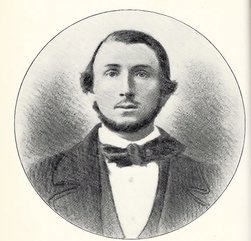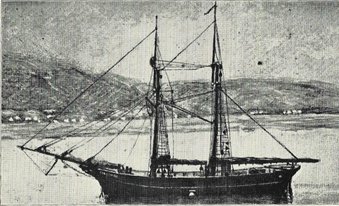MORGAN MARINERS OF TROED Y RHIW
This Morgan clan was part of author D.W. Morgan's family whom he wrote about extensively in the 1947 publication Brief Glory which was a history of the port of Aberdyfi in its heyday. This family had deep roots in Borth, but like others, they moved to Aberdyfi to be close to their maritime activities. Most of the following is taken from Brief Glory and the complex family associations are the work of researcher John Ellis of Aberarth.
The family emerges from the past with John Morgan b.1792, of Borth, who married Anne Moses b.1799 of Llandre in 1818. They had seven children. Anne b.1824, John b.1825, David b.1830, William b.1833, Thomas b.1835, James b.1839, and Sarah b.1843, all the children were born in Borth and lived at Troed y Rhiw. After John's death in 1863 Anne went to live with her children in Aberdyfi until her death in 1881...both she and John are buried in Llandre. A descendant, Phil Williams recently contacted me and he speculates that Sarah b.1843 is in fact the illegitimate daughter of Anne b.1824 as she is listed in the 1861 census as the granddaughter of John and Anne Morgans of Borth....there is a 19 year gap between Sarah and Anne Morgans. Sarah married Evan Davies b1844, a mason of castle Street Aberystwyth, and on their marriage certificate Sarah's father's name is given as John Evans a miner. According to Phil Williams Sarah and Evan went on to have 7 children.
The eldest daughter Anne b.1824 at Borth, married Evan Jones a boatman from Machynlleth and had four children, John 1850-1899, who became a master mariner, Anne b.1835, David 1855-1909 also became a master mariner and William b.1857 who became a cabinet maker. John b.1850 was mate of the Ceres of Aberystwyth as well as the Maglonas of Beaumaris. By 1878 he was master of the Aberdyfi schooner Mervinia which he continued to command until his accidental death in 1899. There is much time dedicated by D.W. Morgan in Brief Glory to this black sheep of the family, his irascible cousin Captain John “Black Jack” Jones. The book details many of his outrages and drinking bouts. Apparently he was not only black in nature but swarthy in appearance. According to D. W. Morgan, with his dark skin and black beard he resembled a Turk. The only redeeming factor, according to D.W. Morgan, was that he would never sail on a Sunday. Black Jack was a larger than life character who is difficult to forget. He met an untimely end early in the morning of Nov 6th 1899 at Roberts Adlard & Co's Slate Wharf, Dock Head, Bermondsey. Jack was probably returning to the Mervinia after a drinking session when the gang-plank slipped as he was crossing over from the quay to the ship. He fell in to the Thames and drowned. His body was returned to Aberdyfi for burial. Morgan. D.W. Brief Glory, Brython Press, 1947, pp.150-156.
MERVINIA
David, Black Jacks brother, born 1855, sailed on the Ceres of Aberystwyth and often sailed in the Mervinia in a number of capacities over the years with his brother Jack. In 1890 he was master of the schooner Catherine Morgan of Aberystwyth and his final command seems to have been a vessel called the Mermaid. By 1898 he became the coxswain of the Aberdyfi lifeboat and remained in that capacity until his death in 1909. The forty year old Catherine Morgan foundered in 1882 near the Varne Lightship; one of the lost crew from Borth is commemorated on a gravestone at the Garn Cemetry.
CATHERINE MORGAN
John born at Borth in 1825, married Ann Morgan of Penparcau b.1815. They had three children, and according to D.W. Morgan their first born son was lost at sea, however there is no reference to him at their grave site in Llandre. We only have John Morgan b.1850 at Borth who died at the age of 16. Morgan b.1853 died aged 15. David b.1856, became a master mariner and was the sole surviving sibling. In Brief Glory he is described as “beloved and legendary figure amongst his relatives, a tall excellent seaman”. David, a.k.a. Dafydd, was mate for years on the schooner Meirion Lass and after a time he began to covet her for himself. His uncle, D.W. Morgan's father, had been the captain so it became very much a family deal when Dafydd persuaded his father John b.1825, to join him in purchasing the vessel. Tragedy occurred 6 months later as Dafydd was struck by the vessel's main boom and knocked overboard on a voyage from Portmadoc to Newport. His grief stricken father sold all his shares to an Irish owner and the vessel was transferred to the port of Dublin. John and Ann Morgan had by then tragically lost all their sons. On page 243 of "Brief Glory" D.W. Morgan described the father as "a gnarled vine nailed to the gable end of a house and stripped of all its blossoms". One should spare a thought for the anguish of the mother whom he did not mention.
David b. 1830, and his brother William b.1833, did not go to sea and little is known of them.
Thomas b.1835 at Borth, was at sea for a time according to his marriage certificate, which states he was a mariner. However it must have been a short career as he became a ships carpenter for the famous ship builder Thomas Richards of Aberdyfi and then moved to Portmadoc to continue his work as a shipwright. Thomas married Bridget Lewis b.1837 of Llanegryn. According to D.W. Morgan she was named after the sloop Bridget, owned and commanded by Whitlock Williams of Moel Ynys. This couple had four children, John Phillip b.1861, Mary b.1863, Elizabeth Ellen b.1870 and Margaret b.1875.
Their son John Phillip had a long and distinguished maritime career. He married Mary Hughes of Nevyn b.1864, and they had one daughter Mary Elizabeth a.k.a. May, who was born in 1897 at Criccieth. Captain John Phillip Morgan began his seafaring career as a 14 year old boy on the Aberystwyth schooner Excelsior. His ships from thereon in were based at Caernarfon. In 1876 he is listed as a cook on the George Casson and then as a seaman on the schooners Catherine Richards, John Evans, Sarah Evans, Ann Holland, David Sinclair, and the Sarah. In 1884 he was bosun on the Mabel and also on the Arabella. He became first mate and served again on the Mabel and then the schooner Florence in that capacity. John's next vessel was the Winifred where he served as a seaman. His next two vessels saw him as mate on the schooners Florence and Theda. The latter was a three masted schooner that made a record passage from Labrador to Gibraltar. He was then mate on the Canadian brigantine Vigilant and became her master in 1889. His next two vessels were the Patra and the David Sinclair.
ARABELLA
In 1883 he returned to command the Aberystwyth schooner John Pierce and whilst on her he nearly came to grief. This vessel had a crew of four men and with John was his wife Mary. They were on a voyage from Poole Dorset, with 150 tons of clay that they were taking to Ellesmere port. By the time they reached Holyhead the weather began to deteriorate and they ended up being driven by a strong current onto Taylor's Bank with no means of removing themselves. Everyone put on their lifebelts and took to the rigging as the hull of the schooner was under water. Everyone expecting to be washed from their perilous position as no-one seemed to answer their distress rockets. Thankfully the steamer Rebecca with Captain Roberts in command approached and a boat was launched and they were luckily all rescued in the dangerous seas that were battering the remains of their vessel. They were all taken to the Sailors Home at Liverpool to recuperate. In 1893 John had to re-apply for his masters certificate as all documents had been lost when the John Pierce foundered.
JOHN PIERCE S.S. REBECCA
His next vessels were the barquentines Ellin Lloyd, and Glenville, the barque Primera then the schooners Elizabeth Llewelyn, Isallt and the Atilla. His last command was the steamer Guildhall. Whilst this vessel was en route from Valencia to Cardiff she was torpedoed by the German submarine U62 forty nautical miles from the Bishops rock, Isles of Scilly, all the crew perished. Tragedy had already visited this family as their only daughter had already been lost at sea in August 1911 at 14 years of age. May and her mother Mary were crossing the Atlantic on the R. M. S. Pretorian to join her father. The last sighting of May was when she was walking the deck in the company of second mate Henry Arthur Ballantine. It is surmised that a large wave swept Mary into the sea and Ballantine drowned whilst attempting to rescue her.
ELLIN LLOYD ISALLT
R. M. S. PRETORIAN PRIMERA
James Morgan born in 1839 at Borth, married Ann Davies in 1866. She was the daughter of Captain David Davies of Borth. James was eight when he began his seafaring career on Captain Davies' vessel the Sarah. James was to have a long career at sea and commanded the schooners Francis Poole, John Wesley, Jane Sophia, Seven Brothers, Meirion Lass, Dewi Lass and the John Stonnard. It was on this latter vessel, he part owned, that he ran into financial trouble towards the end of his career. In 1895 on a voyage to Limerick with a cargo of slates the weather turned nasty around the south west coast of Ireland which meant that the vessel sought shelter near Bear Island. When the weather moderated they made a course for Dursey Head but unfortunately the vessel struck one of the many submerged rocks in the area; it is marked on the chart as Lee rock. The vessel sank with her cargo and Captain Morgan and his crew took to their boat and were able to land safely at Castletown, County Cork. The result of this mishap was that the captain was still liable for the outstanding mortgage of £200 that he had arranged to fund this particular voyage.
DEWI LASS JOHN STONNARD
He was to serve on several vessels but no longer as master; which included the Anne Jane a Portmadoc schooner, the Mervina voyaging to Labrador and the last which must have been a bit of a novelty for him was the steamer Lizzie. With still a debt to service he decided to move his family from Aberdyfi to Liverpool and got a shore job as a docker with Richard Mills and Co. As his son D. W. Morgan recalls in Brief Glory he was working far too hard for his health. James severely crushed his leg in a work accident and had to have his toe amputated. Unfortunately a fortnight later in January 1901 he died. His wife Anne received £200 under the workman's compensation act. Essentially as his son stated he paid off his debt with his life. His body was returned to Aberdyfi to be buried as was his wife Anne's when she later died in 1916.
Little is known of Sarah born in 1843 at Borth
This large family of seafarers can be traced all the way back to the cottage that still stands, called Troed Y Rhiw in upper Borth. Brief Glory written by Captain James Morgan's son is a wonderful read and contains much detail of this Morgan family. For the author of this website it is a treasured book. Despite it being primarily the history of the port of Aberdyfi it contains the history of the important relationship between Borth and Aberdyfi in the days of sail. Borth's contribution was further cemented when historian Lewis Lloyd stated that “Borth mariners were the life blood during the heyday of the port of Aberdyfi”, in his 1996 publication A Real little Little Seaport: The Port of Aberdyfi and its People.
The Morgans married into other seafaring families which D.W. Morgan often refers to in Brief Glory. There were numerous Davies mariners of Borth who were related to the Morgans such as Moses Davies, press-ganged into the Royal Navy during the Napoleonic Wars, Captain Thomas Davies of the sloop Venus, Captain Thomas Davies of the schooners Pluvier and Nathaniel, Captain David Davies who was D.W. Morgan's mother's first cousin who was lost with his crew when the schooner Eleanor Jane sank after encountering a massive storm at the mouth of the Bristol Channel in 1893.
PLUVIER
D.W. Morgan's aunt Elizabeth Davies of Borth married Captain Owen Williams 1838-1924, of Aberdyfi, who had commanded the sailing vessels Star, Kate, Olive Branch, Catherine and the Maglona. They had two mariner sons, one of whom was Captain David John Williams b.1873 who early in his career was one of the few survivors of the sinking of the four masted barque the Wanderer which sank off Holyhead. An event which was later commemorated in a poem by John Masefield who mentioned three sober Welshmen in the crew...one of whom was David John Williams. At 14 years of age he was on the sloop Lerry and then the schooner Jane Owens and from there to the schooner Sarah Davies. Later in his seafaring career he worked for the steamship companies Hall Line and Booth Line. He was torpedoed twice in World War One; once on the S.S. Boniface in 1917 when she was on a voyage from New York to the Clyde.
CAPTAIN OWEN WILLIAMS OLIVE BRANCH
CAPTAIN D. J. WILLIAMS WANDERER
Another of Owen's sons John Davies Williams 1881-1964, was the last child of the ten that Elizabeth of Borth had with Owen before her death. Owen then married Elizabeth's cousin Jane Aspinall of Talybont and had four more children. John's seafaring career began at thirteen years of age when he was ships boy on the Sarah Davies and then the Lady Alice. In a long career in which he circumnavigated the world many times he served as A.B or Bosun on the following vessels: Anne Warren, Mervinia, Gifford, Edward Windes, Bernard Hall, Queen of Cambria, Lizzie, Barbadian, St Kevin, Pluvier, Canadian, and Charlotte Young. In 1914 he was foreman, fitter and rigger overseeing the building of masts at the Marconi wireless station Towyn, and until his retirement was the Trinity Pilot at Aberdyfi. He was involved in two notable rescues whilst a Trinity pilot. It was reported in the Daily Mail that the yacht Svenska with two men and a woman on board, were lucky to have survived when they struck the Dyfi bar in heavy seas. John rowed 2 miles in a small boat out to the stricken vessel and with remarkable skill, helped by two locals they got the crew safely to shore. The Daily Express gave an account of the rescue by John of the S.S. Halton which also grounded on the northern entrance to Aberdyfi. The crew of nine were all huddled for almost two days in the wheelhouse as their vessel was battered unmercifully by huge seas. John, again in a small boat, managed to take food out to the crew in atrocious conditions. Later with the seas abating somewhat he got aboard the vessel and during a high tide bought her safely in to Aberdyfi.
GIFFORD SARAH DAVIES QUEEN OF CAMBRIA
On page 261 of Brief Glory D. W. Morgan draws attention to the fact that Elizabeth in memory of her Borth family (Teulu Sion Dafydd) named her sons David John (Dafydd Sion) and John Davies (Sion Dafydd). The old Borth captains of this branch of the Davies family were the four brothers, David of the Sarah, Thomas of the Venus, Abraham of the Endeavour and John of the Endeavour and Venus.
JOHN DAVIES
Captain Owen Williams's brothers were also master mariners. John was captain of the Jane Owens and Richard master of the Martha & Harriet. Richard's son and namesake became a chemist and moved to Borth and raised a family there. Their story is profiled in this website under the title Elvin and Howard Williams.
JANE OWENS
No-one has summed up Borth's fisher-folk and mariners as well as D.W. Morgan. I often quote his elegiac passages throughout this website. He himself sailed with his father on several vessels and knew at first hand the conditions on Welsh schooners of the 19th century. Even though he chose a career in the Church his love of sailing never diminished.
Much of this material is gleaned from D.W. Morgan's A Brief Glory. The Morgan family tree is the work of John Ellis of Aberarth and Val Bromley of Perth Australia who provided an extensive document on the Williams family. Many thanks to both. I also extend my thanks to Phil Williams.
Also many thanks to maritime historian and author John Gilman of Staffordshire for providing the fine painting ot the Mervinia
